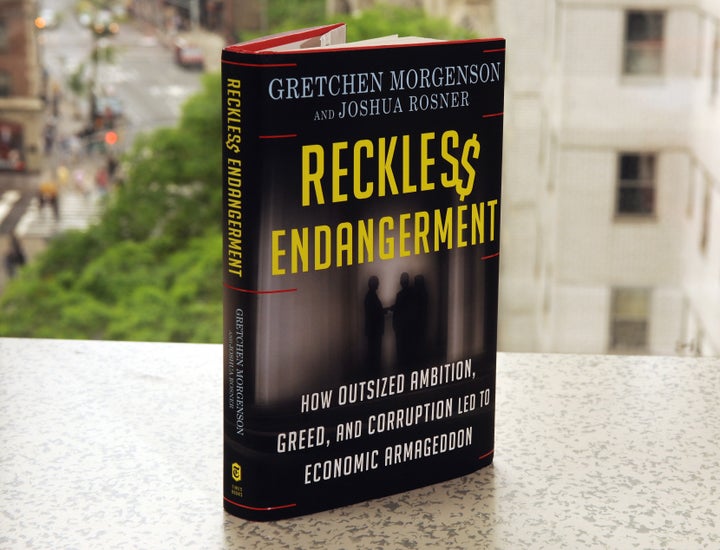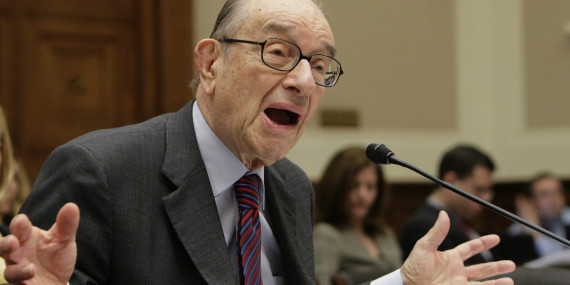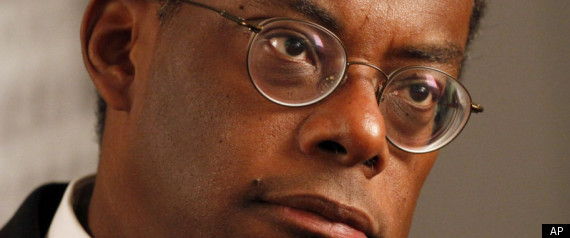
This is an adaptation from "Reckless Endangerment", an exploration of the origins of the recent financial crisis, by Gretchen Morgenson and Joshua Rosner. The book will be published today by Times Books. This excerpt examines the cozy relationship between Alan Greenspan's Federal Reserve and the banks the Fed was charged with regulating. This is the second of three excerpts.
To regulators at the Federal Reserve Board, the financial crisis of 1998 and the collapse of the giant hedge fund Long-Term Capital Management had been an undeniably terrifying event. Officials at the prestigious New York Fed knew how extraordinary it had been for them to help the hedge fund; they were sensitive to the fact that they had aided in a speculator's rescue and worked hard to downplay their role.
In the months and years after the rescue, many Fed officials spoke publicly of the lessons to be learned from the disaster. Chief among them were the dangers of increasingly interconnected world markets and economies and the threats of institutions that had grown so large that their failures could imperil the entire financial system.
"It was a humbling and enlightening experience for us all," said Roger Ferguson, a member of the Board of Governors of the Federal Reserve, in a 1998 speech touching on the Long-Term Capital rescue. "It should cause all of us to reassess our practices and our views about the underlying nature of market risks."
But this advice appears to have been for public consumption only because it went unheeded, especially within Ferguson's own organization. Indeed, the Fed seemed to have conducted precious little soul-searching as the 1998 crisis receded into the mists of investors' memories.
One big reason everyone felt they could move on from the LTCM mess was the stupendous performance of the stock market, especially the technology sector. It is an investing truth that rising markets create complacency and in late 1998, with the Dow Jones Industrial Average marching inexorably to the never-before-scaled 10,000 level, investors were especially unfazed. The index of 30 industrial stocks had started off the 1990s at 2,753, but in March 1999 it closed above 10,000 for the first time.
It was a bubble that would create tens of billions in losses and considerable angst when it popped in 2000. But while the good times were rolling, top financial regulators like Alan Greenspan exulted over the wonders of technological advancements. Although it was obvious to many that the technology stock mania would end badly, Greenspan and his colleagues at the Fed refused to tamp down the euphoria. They could have raised margin requirements, for example, increasing the amount of their own money investors had to put up to buy stock using borrowed funds.

Even as they ignored the stock market bubble, these very regulators were laying the groundwork for a subsequent, far more virulent mania in the credit markets -- which helped finance, among other things, mortgages and home ownership. Regulators did this by siding with the banks that wanted to loosen the capital strings that bound them, too tightly they thought, in this brave new world.
Unfettered capitalism coupled with the ownership society-- where individuals were invited to participate in the wealth creation engine of the financial markets-- had become a potent combination. It had produced riches for corporate executives and considerable wealth for individuals, and had replaced federal deficits with an unheard-of government surplus, generated largely from taxes paid by investors on their market gains.
The belief that the free market could police itself better than any government regulator had already taken hold. So, even as Ferguson and other Federal Reserve officials paid lip service to the important lessons of the 1998 crisis, their actions showed that they ignored those lessons. Instead of heightening the scrutiny of risky practices among the big banks they oversaw, the Fed backed these institutions' desires to reduce capital requirements and increase their leverage and profits. Instead of reining in financial institutions in areas that could result in losses, Fed officials loosened them.
In other words, the Fed was busy becoming a pushover, not a policeman.
"It was explicit in those years, if you worked inside the Fed, that you were partners with the banks," said a former Fed official. "You were not adversaries."
One of the banks' crucial partners at the Fed, albeit behind the scenes, was Ferguson, the vice chairman. From 1997, when he joined the Federal Reserve as a governor, until he resigned to return to the private sector in 2006, Ferguson was a strong advocate for the banks among global financial regulators.
President Clinton appointed Ferguson vice chairman of the Fed in 1999. He began his career as a lawyer at Davis, Polk & Wardwell, advising some of the nation's largest banks on mergers and acquisitions, initial public offerings, and syndicated loans. Davis, Polk was closely linked to the Fed; years later, during the financial maelstrom of 2008, the firm would advise the New York Fed on its various bailouts.
Ferguson was also the Fed's point man on the Basel Committee, the group of central bankers and international financial regulators that met regularly to discuss and hammer out international banking standards. And according to those who interacted with Ferguson in this capacity, he consistently pushed for rule changes requested by the nation's largest banks and that were beneficial to them.
In 1998, when the Fed governors voted 5-0 to approve the mega-merger of Citibank and Travelers, Ferguson abstained. His wife, Annette Nazareth, was a managing director at Smith Barney, a Travelers unit, when the application was being considered.
In a speech in October 1999 to the Bond Market Association in New York City, Ferguson outlined his preference for less, not more, regulation. "Heavier supervision and regulation of banks and other financial firms is not a solution, despite the size of some institutions today and their potential for contributing to systemic risk," he said. "Increased oversight can undermine market discipline and contribute to moral hazard. Less reliance on governments and more on market forces is the key to preparing the financial system for the next millennium."
A belief had arisen during the late 1990s that bankers had so improved their risk-management and loss-prediction techniques that regulators could rely on the banks to decide how much extra funding they needed to keep in their coffers in case of a financial downturn -- a surplus guided by regulatory measurements known as "capital standards."
Not everyone agreed that it was prudent to rely on the banks themselves for guidance -- certainly the FDIC rejected the notion. But the Fed was among those regulators who were more than willing to put the bankers in the driver's seat. Others were the Office of Thrift Supervision, which oversaw savings banks, and the Comptroller of the Currency, which scrutinized large national banks.
Executives at the big banks knew that their profits would be bolstered if they could reduce the amount of money regulators required them to set aside for problem loans. Smaller set-asides meant more money to be deployed in lending or purchases of income- producing securities. Banks also recognized that higher profits meant loftier executive pay.
But reducing capital requirements would also leave the banks in a more perilous position if their loans and investments went bad. And thanks to the elimination of Glass-Steagall, banks were now allowed to extend and expand their operations almost without limit. Such expansion increased the likelihood of losses in the years ahead.
The Fed bought into the banks' argument that because losses and bank failures had been rare during the mid-to-late '90s, this was evidence that these institutions had become better at managing their risk taking. Top Fed officials ignored one of the most basic lessons in economics -- that even though the sun may be shining today, you should set aside money for the inevitable rainstorm.
Others, such as Chairman Greenspan, seemed to have consciously decided that because it rained so infrequently, it wasn't worth discussing such an outcome. In a 2000 speech, he said: "We have chosen capital standards that by any stretch of the imagination cannot protect against all potential adverse loss outcomes. There is implicit in this exercise the admission that, in certain episodes, problems at commercial banks and other financial institutions, when their risk-management systems prove inadequate, will be handled by central banks."
In a May 2002 speech in Lexington, Va., Ferguson weighed in: "Any regulatory capital standard must, of course, require banks to hold an amount of capital sufficient to get them through, not the worst imaginable, but nevertheless rough times. Competition within the industry and among banking systems of different countries often presses for less. Such pressures must be resisted."

But internally, at meetings in which the new standards were discussed among regulators and market participants, granting the banks' wishes seemed to be the Fed's priority, according to a regular attendee.
The Fed concluded that regulators could use banks' own risk metrics to devise capital requirements because the regulator started from the position that these institutions had learned to estimate losses more reliably than they had in the past.
To some outside the Fed, relying on banks' figures represented, at best, a delegation of an important oversight task and, at worst, a dereliction of duty. "They were going to the industry to get a lot of the data," the fellow regulator said. "They were calibrating their formulas off the banks' data. The Fed would have been hard-pressed to even come up with the estimates because only the banks really had the data."
Some regulators argued that instead of relying on banks' estimates of future losses, a better approach would be to determine capital requirements using actual losses that the banks had experienced in the 1980s and 1990s. Applying those real and painful losses to the equation, officials at the FDIC concluded that the new capital requirements left little room for error if banks experienced losses outside their own estimates.
"The Fed's worldview was dominated by the big banks," the fellow regulator said. "If you look back at all the things that were done, all the rulemaking was in the same direction -- that the banks knew what they were doing and we needed to rely more on their internal systems."
This view came through loud and clear in meetings at the New York Fed's wood-paneled boardroom where regulators and the big banks discussed the new capital requirements. According to a regulatory official who attended these meetings, the message transmitted to the banks was to fear not, the Fed was on their side.
"At one of the first meetings I went to," this official said, "there were people from the highest levels of all the regulatory agencies, both policy and staff, along with chief risk officers at the top 10 banks. The banks were told point-blank the changes were going to be attractive from a capital standpoint."
Although after the financial crisis occurred Ferguson denied that he and others at the Fed had transmitted a dual message, its existence could not have been clearer to participants in these meetings. In public speeches, at congressional hearings, Fed officials insisted it had no interest in reducing capital requirements. But behind the scenes, the message to the banks was an emphatic "we understand where you are coming from" and "we're on your side," one participant said.
The Fed also angered its fellow regulators by maintaining a disturbing secrecy about the figures and formulas it was using to come up with the new capital requirements. According to people involved in the discussions, the Fed repeatedly pushed back against the FDIC's desire to publish tables showing the range of effects that capital changes would have on different institutions. These tables showed how the big banks benefited from the proposed rule changes far more than small banks did.
"When you publish a bunch of formulas with a lot of Greek letters it's hard to understand what that means," said one regulator involved in the battle. "They did not want to risk having the small banks get wind of the differences and raising a stink on Capitol Hill."
The FDIC prevailed, however, and the tables were included. As it happened, the credit crisis hit before many of the changes suggested by the Basel Committee and backed by the Fed could be implemented. But as banks wrote down hundreds of billions in bad loans and sought on-the-fly ways to press for accounting changes that would protect them from writing down hundreds of billions more, it was evident that relying on the banks' loss estimates to reduce capital requirements would have been a disastrous decision. It would have made the crisis even more devastating than it was.
The Fed's determinedly bank-centric approach in the years leading up to the 2008 financial crisis meant banks were dangerously undercapitalized just when they most needed large cash cushions to protect against losses.
But even after it had become clear that the Fed had been wrong to push for relaxed capital standards, the regulator continued to take a pro-bank worldview in its various rescues of big banks hobbled by bad credit decisions.